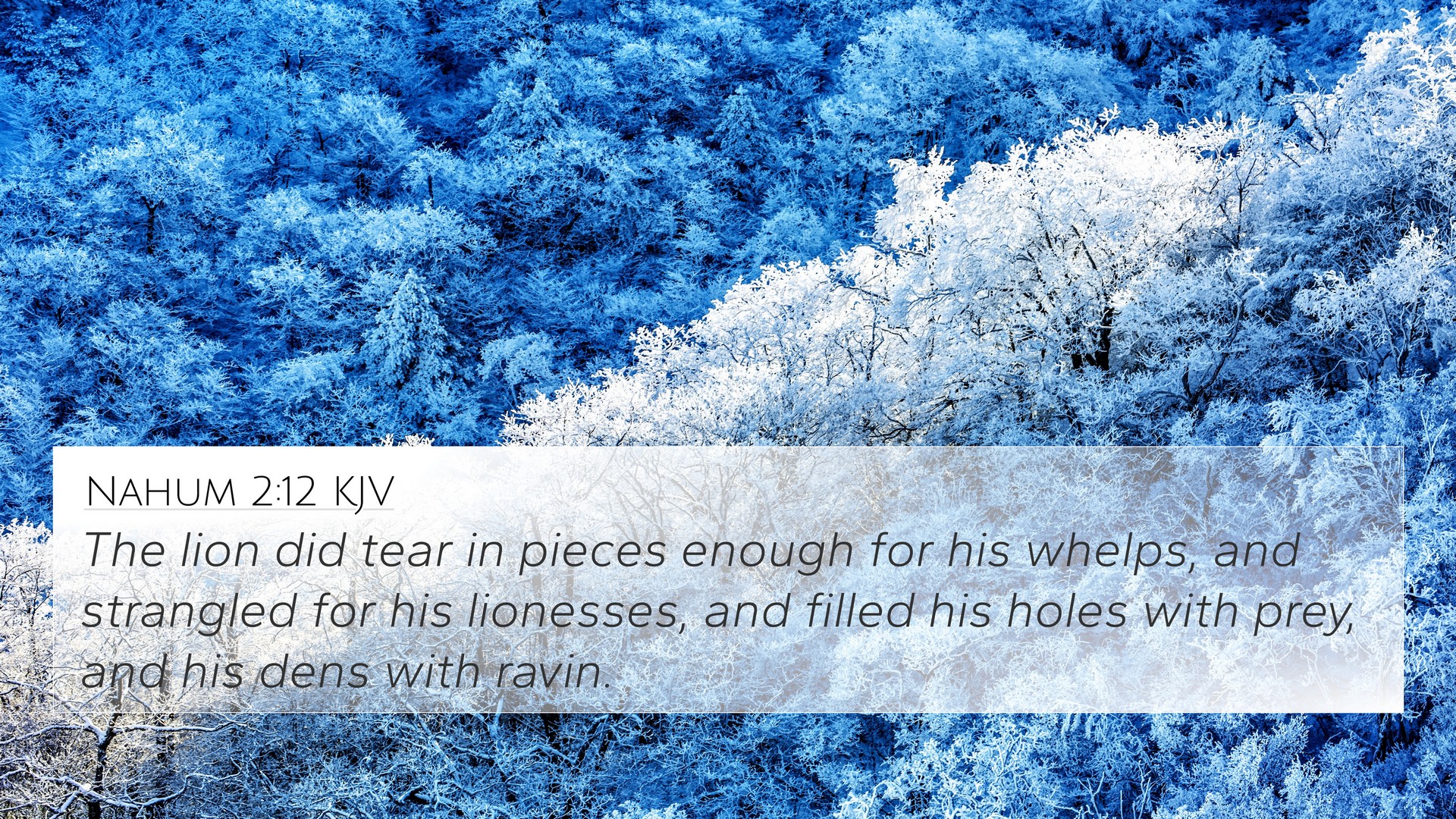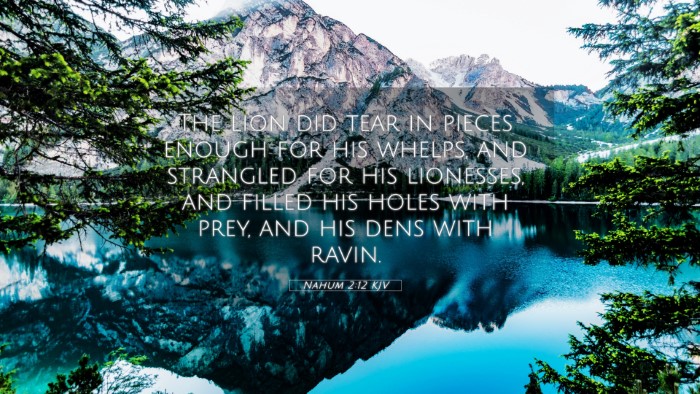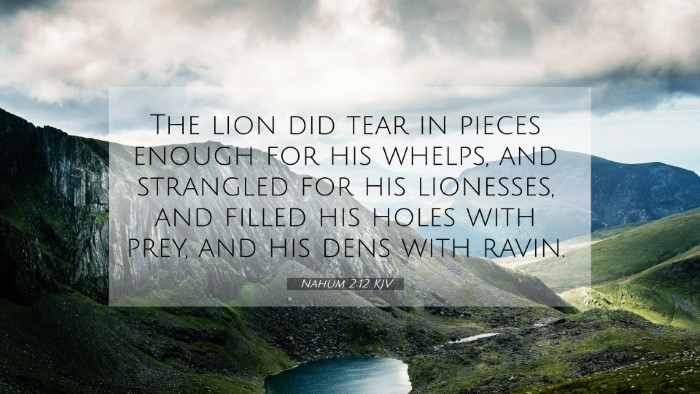Old Testament
Genesis Exodus Leviticus Numbers Deuteronomy Joshua Judges Ruth 1 Samuel 2 Samuel 1 Kings 2 Kings 1 Chronicles 2 Chronicles Ezra Nehemiah Esther Job Psalms Proverbs Ecclesiastes Song of Solomon Isaiah Jeremiah Lamentations Ezekiel Daniel Hosea Joel Amos Obadiah Jonah Micah Nahum Habakkuk Zephaniah Haggai Zechariah MalachiNahum 2:12 Similar Verses
Nahum 2:12 Cross References
The lion did tear in pieces enough for his whelps, and strangled for his lionesses, and filled his holes with prey, and his dens with ravin.
Uncover the Rich Themes and Topics of This Bible Verse
Listed below are the Bible themes associated with Nahum 2:12. We invite you to explore each theme to gain deeper insights into the Scriptures.
Nahum 2:12 Cross Reference Verses
This section features a detailed cross-reference designed to enrich your understanding of the Scriptures. Below, you will find carefully selected verses that echo the themes and teachings related to Nahum 2:12 KJV. Click on any image to explore detailed analyses of related Bible verses and uncover deeper theological insights.
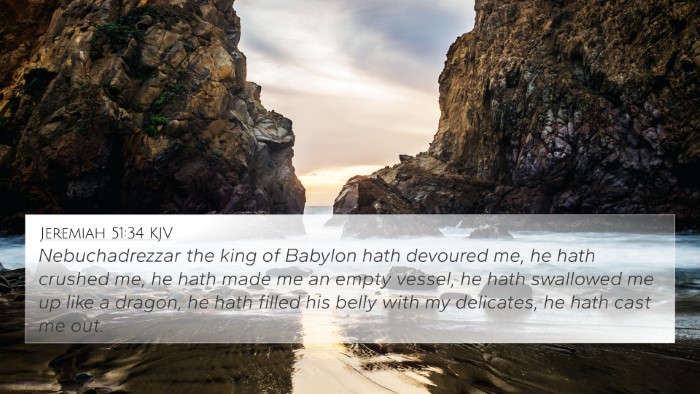
Jeremiah 51:34 (KJV) »
Nebuchadrezzar the king of Babylon hath devoured me, he hath crushed me, he hath made me an empty vessel, he hath swallowed me up like a dragon, he hath filled his belly with my delicates, he hath cast me out.

Psalms 17:12 (KJV) »
Like as a lion that is greedy of his prey, and as it were a young lion lurking in secret places.
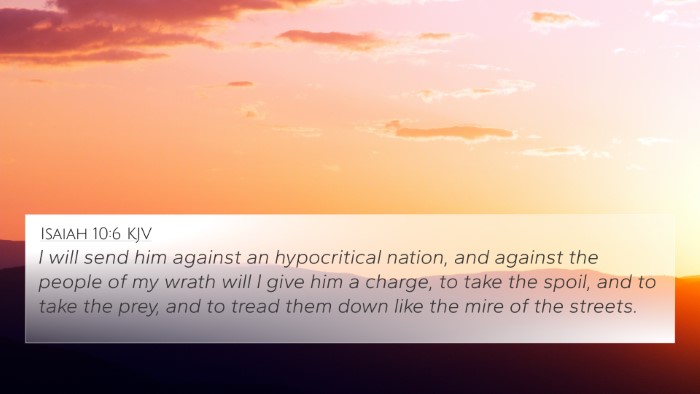
Isaiah 10:6 (KJV) »
I will send him against an hypocritical nation, and against the people of my wrath will I give him a charge, to take the spoil, and to take the prey, and to tread them down like the mire of the streets.
Nahum 2:12 Verse Analysis and Similar Verses
Nahum 2:12 - Verse Meaning and Interpretation
Nahum 2:12 states:
"The lion did tear in pieces enough for his whelps, and strangled for his lionesses, and filled his holes with prey, and his dens with ravin."
Summary of Insights
This verse from the Book of Nahum vividly illustrates the destruction of Nineveh, the capital of Assyria, showcasing the imagery of a lion tearing apart its prey. The metaphor of the lion serves to depict the fierce military prowess and greed of the Assyrians, who previously inflicted great suffering upon other nations. Let's delve into the interpretations from well-respected public domain commentaries.
Matthew Henry's Commentary
Matthew Henry emphasizes the ferocity and dominance of the Assyrian Empire, represented as a lion that has preyed upon nations. He notes that the reference to "whelps" indicates not just the lion's strength, but also the offspring that would carry on this cruel legacy. According to Henry, this imagery represents God's judgment against Nineveh, highlighting that their tyranny will ultimately lead to their downfall.
Albert Barnes' Notes
Albert Barnes expands upon the imagery of the lion, illustrating how it demonstrates the audacity of Nineveh's conquering nature. He emphasizes that the language suggests a complete desolation—where once there was strength and power, there will now be emptiness. Barnes connects this to the theme of divine retribution, where the very strength Nineveh once displayed will be their undoing as God avenges the oppressed.
Adam Clarke's Commentary
Adam Clarke interprets the verse focusing on the natural characteristics of lions, which symbolize strength and predation. Clarke suggests that the lion metaphor also carries a dual meaning—while the lions’ strengths depict the Assyrian power, it also conveys an impending judgment, where the predator will become the prey. This aligns with Clarke’s belief that God will not allow such cruelty to persist indefinitely.
Thematic Connections and Cross-References
The verse speaks not only to the destruction of Nineveh but also carries broader biblical themes of judgment, retribution, and the cyclical nature of power. Here are some related Bible verses that help to draw connections:
- Isaiah 31:4: "For thus hath the Lord spoken unto me, Like as the lion and the young lion roaring on his prey..." - A reference to God's protective nature as well as impending judgment on nations.
- Jeremiah 50:17: "Israel is a scattered sheep; the lions have driven him away..." - Usage of lion imagery to convey the devastation faced by God’s people.
- Ezekiel 22:25: "There is a conspiracy of her prophets in the midst thereof, like a roaring lion ravening the prey..." - Illustrates the destructive force of false prophets.
- Amos 3:8: "The lion hath roared, who will not fear?" - A proclamation of God's authority.
- Hosea 5:14: "For I will be unto Ephraim as a lion, and as a young lion to the house of Judah..." - God's imminent judgment is analogous to a lion's attack.
- Revelation 5:5: "Weep not: behold, the Lion of the tribe of Judah, the Root of David, hath prevailed..." - Contrast between the judgment depicted in Nahum and the victory of Christ.
- 1 Peter 5:8: "Be sober, be vigilant; because your adversary the devil, as a roaring lion, walketh about, seeking whom he may devour." - Warning about spiritual vigilance against aggressive forces, similar to the destructiveness of Assyria.
Understanding and Applying Cross-Referencing
When studying Nahum 2:12, it's essential to utilize tools for Bible cross-referencing to deepen your understanding:
- How to find cross-references in the Bible: Familiarize yourself with a Bible concordance or a cross-reference guide.
- Bible cross-reference guide: These guides can help connect various scriptures thematically and contextually.
- Cross-reference Bible study: Integrating studies across verses enhances comprehension of themes such as judgment and redemption.
Conclusion
Nahum 2:12 is rich in imagery and power, linking the fates of nations with divine justice. Understanding this verse in context, and alongside connected scriptures, reveals a deeper theological significance that encompasses God's sovereignty, the moral narrative of retribution, and the ultimate hope found in Christ.
Additional Cross-References for Further Study
As you continue to explore the connections between Bible verses, consider these approaches:
- Identifying connections between Old and New Testament: Observe how themes developed in the Old Testament are fulfilled or reinterpreted in the New Testament.
- Comparative study of Pauline epistles: Look for echoes of Old Testament scenarios in Paul's letters as he writes about the implications of judgment and grace.
- Bible verses related to [specific theme]: Searching for verses tied to specific themes allows contextualization and deepens understanding.
- Links between the Prophets and Apostolic teachings: Use cross-referencing to discover how prophetic literature informs the teachings of the apostles.
- Bible cross-references for sermon preparation: Leverage cross-referencing techniques to build sermons that are rich in biblical truth.
Engagement with Scripture
Engage actively with the language and imagery of Nahum 2:12 by reflecting on its implications for today. This allows readers to not only grasp historical contexts but also apply these truths to modern-day faith and understanding.
